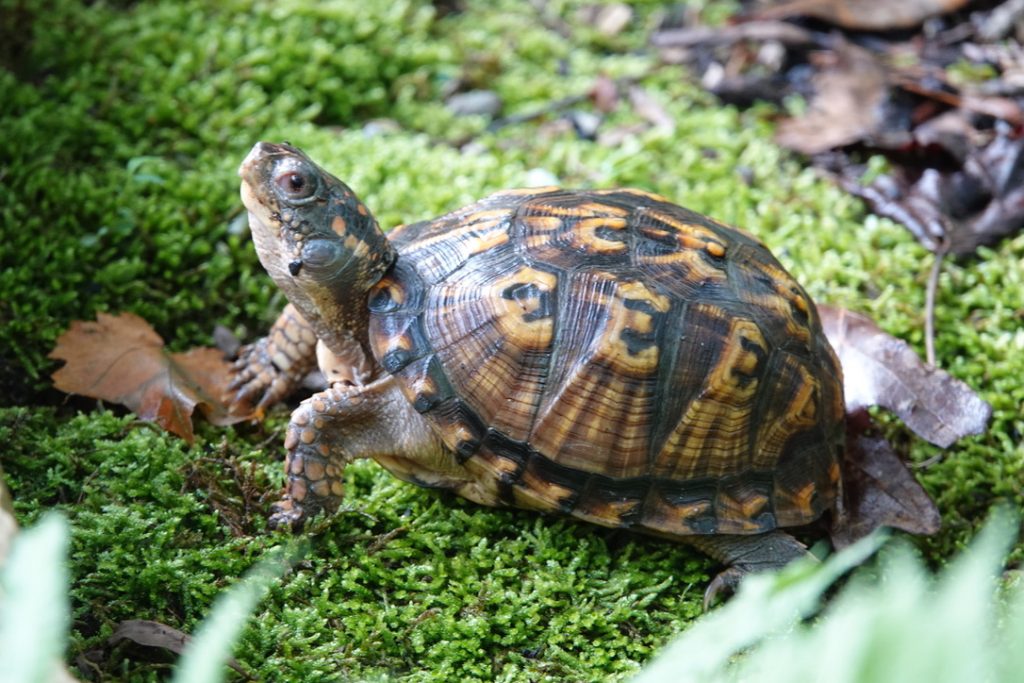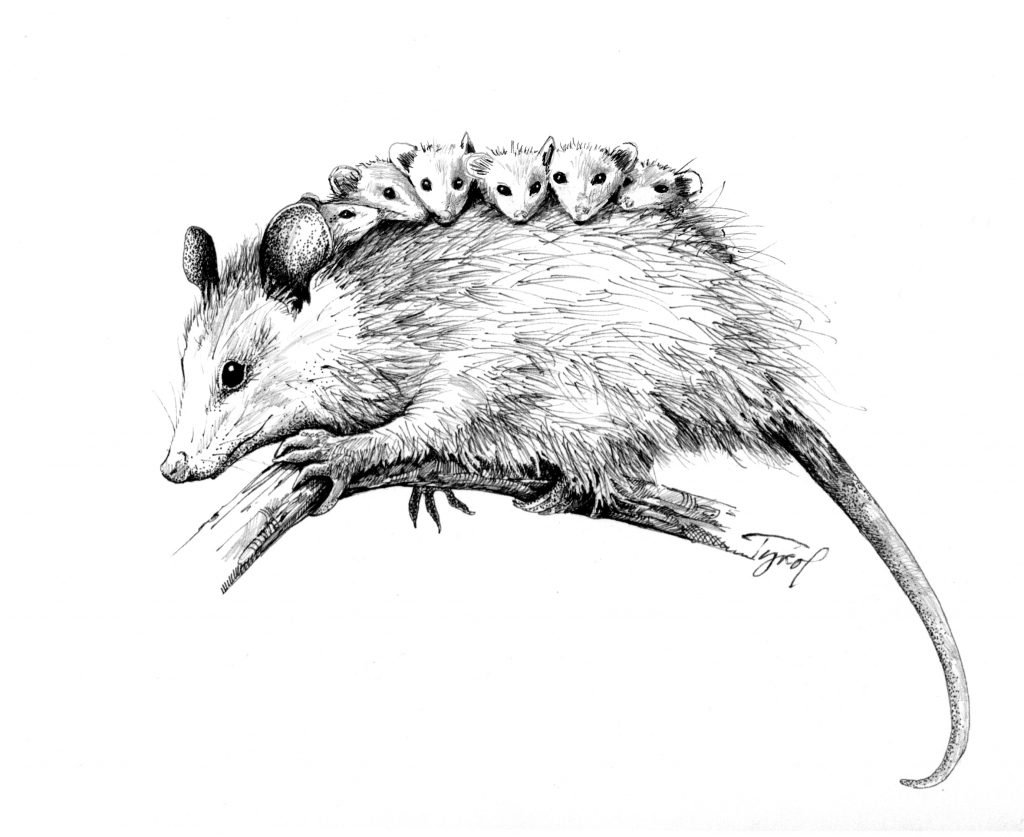How to Do Successful Wildlife Rescues
How to Do Successful Wildlife Rescues

This box turtle is one of our many wildlife rescues.
Our first of several opossum rescues

Sometimes mama opossums and her babies need help. Illustration: Adelaide Tyrol
Shortly after Dale & I meet, we find a mama opossum with a bunch of babies in Dale’s empty swimming pool. Yes, we realize the pool should have a cover but we now have to deal with the situation at hand.
How do we get them out? The mama is hissing at us every time we get near so picking her up is not going to happen. Dale puts on his engineering hat (his degree in aerospace technologies often comes in handy) and builds a ramp out of the pool with some boards. We slather cat food on the boards to entice the mama and put a bowl of water in the pool near her. Then we leave.
The next morning the mama and her babies are gone. Yea, a success. Now we need to get that pool covered!

A bat arrives on our front porch right before a snow storm. Who ya going to call?
A bat rescue
What do you do when a little brown bat shows up on your front porch with a major snowstorm predicted? First, we called our local wildlife rescue. Unfortunately, at the time, the law wouldn’t allow them to accept bats. The good news, in North Carolina, the law changed in 2020 and bats can now be rehabilitated.
After some brainstorming, we decide to call the world’s expert on bats, Merlin Tuttle. We met Merlin and his wife, Paula, on an amazing trip to Austin. You can read about our adventure with Merlin & Paula to see 15 million bats in our blog, “World’s Most Mammals“.
Merlin picks up on the first ring. He counsels us to put it in a box in a heated spot (using gloves in the very remote chance it has rabies), let it rest and warm up and then see if it will fly away after dark. But there is a snowstorm coming… We really have no other choice and bats will live through snowstorms, Merlin tells us. After letting the bat rest and get warm, Dale takes the bat outside on the end of a shovel. As he lifts the little bat toward the sky it flys off. Hooray!
I still worry about it with the storm coming, but at least we give it a chance. Bat rescues can be tricky, but this one seems to be a success.
An almost diastrous box turtle rescue
![]()

Our rescue of a box turtle had a happy ending, barely!
We are thinking ahead. In order to plant some new native shrubs, we dig some big holes in our front garden. The plants will arrive tomorrow. It rains during the night which is perfect!
Then Dale looks down on the garden from our upstairs bedroom and sees something floating in one of the holes. Oh no! We race outside and find a box turtle floating upside down. OMG, is it still alive? Have we just killed a beloved turtle?
Luckily, the box turtle seems just fine after we dry it off and place it in some moss hidden under a shrub. We check on it every few minutes and within an hour, it has disappeared. The lesson we learn? Do not ever leave open holes in your garden.
Our mouse rescue goes awry

Our mouse rescue goes awry.
So what is our rescue failure? It has to do with a little mouse that happened to find its way into our pantry. Not wanting to hurt it, we use one of the safe animal traps and catch it right away. It must be the peanut butter we left.
We come up with the perfect place to release it at a nearby park where there is a little stream and plenty of shelter. So off we go with the mouse in the trap. After releasing the little one, we bask in our success.
Only to find out, we probably gave it a death sentence moving it so far away. What we learned is you should release the animal right outside your house, where they are used to living, and then plug the holes where it might try & reenter. A great article by the Humane Society, Scrap the trap when evicting wildlife, explains why animals will probably not survive when you move them far away.
There are several reasons. They can’t find the food they have stored. Babies might have been left behind. And in unfamiliar territory, they are more likely to be eaten by a predator.
We hope for the best for the little mouse but we now consider this a dismal failure. One which we will not repeat!
Our second opossum rescue

A successful opossum rescue
Our second opossum wildlife rescue has a happy ending. As we are driving to our local park, we see something on the road. Oh no, the driver is going to hit it. OMG, it is a little opossum!
As the driver sees it, she throws her hands up in the air, looks at us and keeps driving. Absolutely infuriating, but luckily the little opossum rolls under the car and just seems stunned. We stop our car, wrap it up in my jacket, which is brand new.
I move it to the side of the road until we can park the car. By the time we get back to the opossum, it is sitting up but a giant orange cat is now approaching. Even I was scared of the cat! I scoop it back up and walk it over to our nearby park (Harmon Field) and set it down in a place where it can find its way back home easily.
Luckily, a few minutes later it disappears into the thicket. If the opossum had been severely hurt, we would have called Appalachian Wildlife Refuge, our local animal rehabilitator in Western NC for help.
So what do you do if you find an injured animal?
If you find an animal you think is abandoned or injured, call a wildlife rehabilitator. But first, make sure the animal needs help.
Many animals leave their young to go forage and soon return for their baby/babies. If you don’t know a local wildlife rehabilitator, check out the website Animal Help Now. They can help direct you to someone who can help.
We call Appalachian Wildlife Rescue for injured animals in western NC. Also, try and remember the spot where you found the injured animal. It is always best to return the rehabbed animal to its original home when possible.
And last, thank you for caring. Every animal is precious especially the misunderstood ones. They deserve a chance to live their lives as Mother Nature intended.
